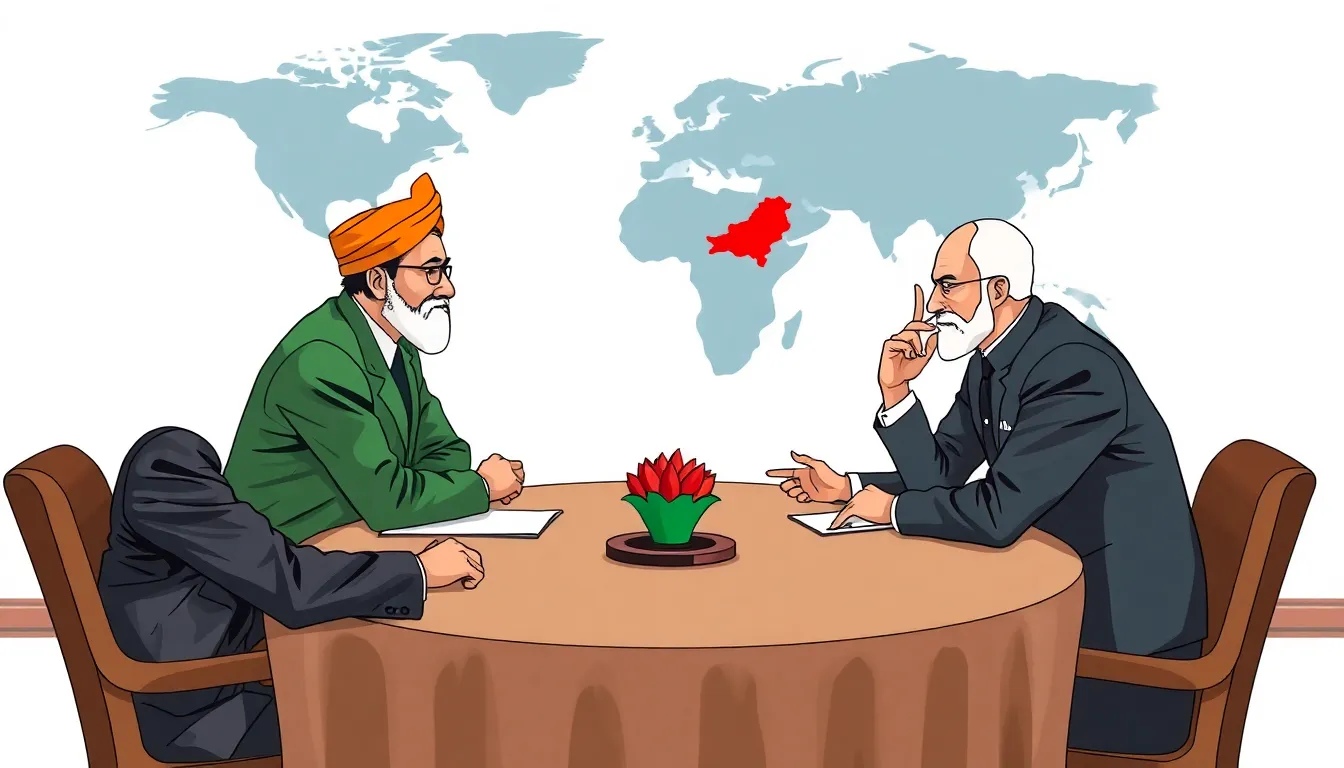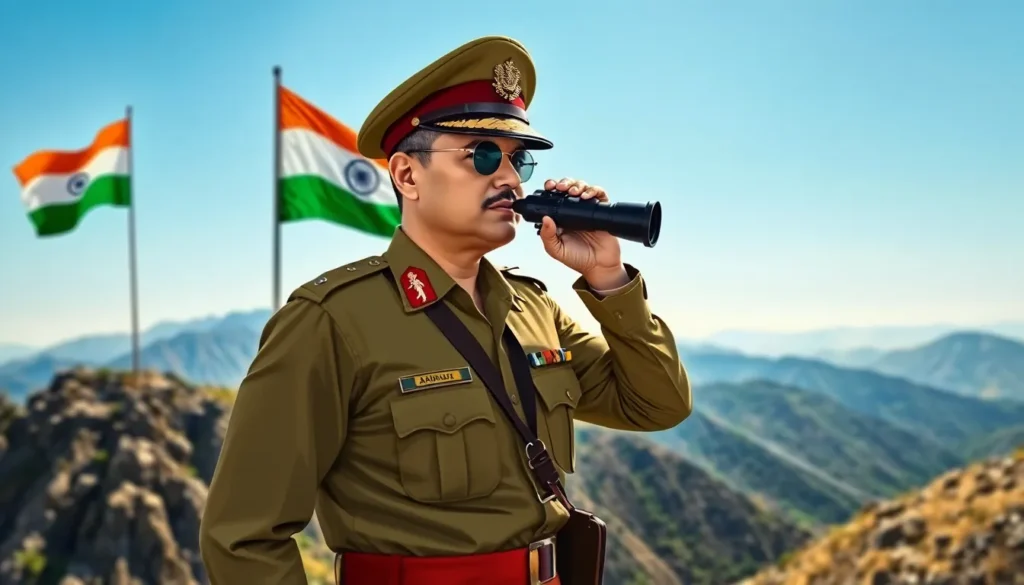Table of Contents
ToggleAs 2025 unfolds, the simmering tensions between India and Pakistan have become a hot topic, sparking debates that could rival the excitement of a cricket match. With both nations navigating a complex web of history, politics, and the occasional mischief, the stakes are higher than ever. It’s like watching a suspense thriller where the plot twists keep coming, and the characters are all too familiar.
Overview of India Pakistan Tensions
Tensions between India and Pakistan continue to heighten as 2025 unfolds. Historical grievances primarily shape the conflict, with events from the partition in 1947 remaining pivotal. Both nations maintain a complex relationship, marked by territorial disputes, particularly over Kashmir. India’s military presence in the disputed region escalates regional tensions, prompting occasional skirmishes along the Line of Control.
Recent developments include increased diplomatic talks aimed at reducing hostilities. Analysts note that the fluctuating political landscape in Pakistan significantly impacts bilateral relations. For instance, changes in leadership often lead to shifts in policy regarding India, affecting not only diplomatic ties but also trade agreements.
Military posturing from both countries amplifies fears of escalation. India’s defense budget for 2025 includes considerable investments in modernizing its military capabilities. In contrast, Pakistan, facing economic challenges, seeks military support from allies to maintain a balance.
Public sentiment plays a critical role in shaping perceptions of the conflict. Nationalistic fervor in both countries often influences government policies and media narratives. Grassroots movements advocating for peace sometimes struggle against hindering political agendas.
International involvement remains significant, as global powers express interest in stabilizing the region. The United States and China continue to engage both nations, seeking to ease tensions through diplomatic channels. Neutral mediation is seen as essential for fostering lasting peace agreements.
Ongoing debates around these tensions reflect deep-rooted conflicts, with each side holding firm to its narrative. This situation could evolve unpredictably, much like a suspense thriller where the storyline shifts suddenly.
Key Events Leading to 2025

Tensions between India and Pakistan continue to evolve dramatically as 2025 progresses. The interplay of various events shapes the future of this long-standing conflict.
Historical Context
Conflicts trace back to the 1947 partition, establishing a complex backdrop. Territorial disputes over Kashmir represent a crucial flashpoint, influencing relations over decades. Each nation’s historical grievances contribute to ongoing animosities. Military engagements since the partition solidify entrenched positions. Events like the 1965 and 1971 wars further complicate any potential reconciliation. Notably, the Kargil conflict in 1999 amplified distrust, undermining peace efforts. Throughout these years, efforts for dialogue frequently faltered, continuing the cycle of tension.
Recent Developments
Recent years reflect increasing diplomatic initiatives aimed at easing hostilities. High-level meetings between political leaders have occurred sporadically, expressing a willingness to address key issues. Economic challenges in Pakistan push its leadership to reconsider policy towards India, seeking stability. Concurrently, India’s military modernization raises concerns, prompting Pakistan to seek international support. Public opinion in both countries significantly impacts government decision-making. Additionally, social media amplifies nationalistic sentiments, complicating peace advocacy. Global powers like the United States and China engage both nations, advocating for stability through dialogue. Such international mediation plays a pivotal role in the ongoing dynamics.
Political Dynamics
Tensions between India and Pakistan remain high as 2025 progresses, influenced by a complex web of political dynamics.
India’s Stance and Policies
India maintains a robust military presence along the Line of Control to deter escalating threats. Diplomatic engagement occurs intermittently, aimed at addressing core issues, particularly the Kashmir conflict. Recent initiatives highlight India’s commitment to security, emphasizing modernization of defense capabilities. Nationalist sentiments drive policymaking, often framing Pakistan as a primary adversary in public discourse. Additionally, economic growth shapes India’s confidence in pursuing a strong stance, influencing regional geopolitics. Apart from military considerations, India engages in strategic partnerships with global powers to enhance its diplomatic leverage.
Pakistan’s Response
Pakistan’s response reflects a complex interplay between economic challenges and military strategy. Ongoing leadership changes in Pakistan impact its approach to India, leading to shifts in policy. Recent dialogues signal an openness to explore peace talks, albeit amidst skepticism. Economic instability pressures Pakistan to seek stability through diplomacy, prompting reassessment of its historical stance. Pakistan also strengthens military alliances with supportive nations, bolstering its defense posture. Public sentiment often tilts towards nationalism, complicating the government’s efforts to engage in constructive dialogue with India. The balance between domestic pressures and external diplomatic efforts remains delicate.
Impact on Regional Security
Tensions between India and Pakistan continue to shape regional security dynamics significantly. The military and diplomatic dimensions play crucial roles in this context.
Military Developments
Strategic deployments along the Line of Control remain a priority for India. They’ve enhanced surveillance capabilities and modernized weapons systems to adapt to evolving threats. Pakistan counters these maneuvers by bolstering its defense infrastructure and enhancing military readiness. Recent defense exercises showcase Pakistan’s commitment to maintaining its deterrent posture. Both nations’ military posturing contributes to a delicate balance that could shift at any moment. Notably, these developments underscore potential flashpoints that may ignite further conflicts. Heightened troop concentrations and advanced weaponry raise stakes, impacting not just India and Pakistan but also the surrounding nations.
Diplomatic Efforts
Diplomatic dialogues, including informal talks and backchannel communications, are ongoing between India and Pakistan. Several recent initiatives represent attempts to bridge gaps and address shared concerns. India’s government expresses openness to negotiations, emphasizing bilateral discussions focused on Kashmir. Pakistan, despite internal challenges, signals a readiness to engage in talks, seeking stability through diplomatic avenues. Both countries experience internal public pressure, complicating their ability to pursue peace consistently. Nonetheless, international stakeholders encourage discussions, underscoring their importance for regional stability. External powers play vital roles in facilitating dialogue, yet skepticism lingers on both sides, hindering substantial progress.
Media Coverage and Public Perception
Media coverage significantly shapes public perception of India-Pakistan tensions. Journalistic narratives often emphasize military engagements and political statements, portraying an ongoing rivalry that captivates audiences. Coverage tends to focus on historical grievances, particularly the Kashmir issue, framing it as the core of the conflict. Analysts frequently highlight how both nations sustain nationalist sentiments, influencing government decisions and public attitudes.
Television channels, newspapers, and online platforms present contrasting viewpoints, which can polarize public opinion. For instance, Indian news outlets often highlight security concerns, showcasing India’s military preparedness. These reports typically resonate with nationalistic themes, reinforcing perceptions of Pakistan as a determinant threat. Conversely, Pakistani media emphasize economic challenges and peace initiatives, though skepticism about India’s intentions remains prevalent.
Social media amplifies these narratives, allowing rapid dissemination of information and opinion. Users on platforms frequently express strong emotions, which complicate grassroots peace efforts. Activists advocating for dialogue face considerable opposition, as nationalist rhetoric often dominates conversations. Consequently, public sentiment can fluctuate dramatically based on trending narratives or significant events.
Recent surveys reveal that a notable percentage of citizens in both countries support peace talks, yet fear and distrust persist. Poll results reflect that many individuals desire stability but remain wary of proposed negotiations. Governments face challenges navigating these complex public sentiments, influenced by media portrayals. Ultimately, the relationship between media coverage and public perception underscores the importance of balanced and factual reporting to foster a constructive dialogue.
As 2025 unfolds the tensions between India and Pakistan continue to evolve amidst a backdrop of historical grievances and military posturing. Both nations remain locked in a complex rivalry where public sentiment and media narratives play significant roles in shaping perceptions. The willingness for dialogue exists but is often overshadowed by skepticism and nationalist rhetoric.
The delicate balance of military readiness and diplomatic efforts will be crucial in determining the future trajectory of their relationship. With external powers also influencing the dynamics ongoing developments will likely keep this situation in the spotlight. The path to lasting peace remains uncertain yet essential for regional stability.




